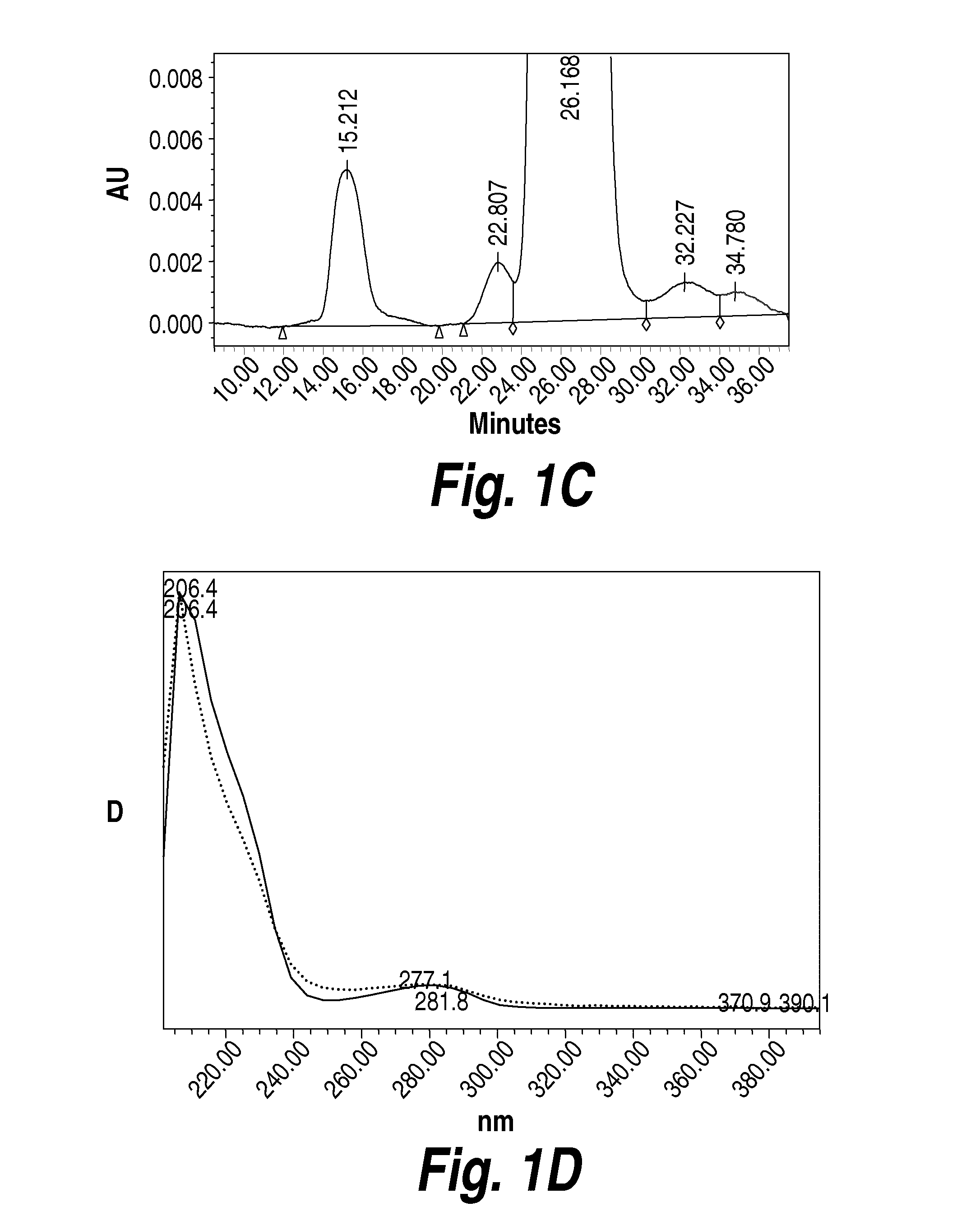Methods and compositions for CNS delivery of heparan N-sulfatase
a technology of heparan nsulfatase and composition, which is applied in the direction of peptide/protein ingredients, inorganic non-active ingredients, metabolic disorders, etc., can solve the problems of poor diffusion of active agents from the site, tissue damage, immune responsiveness, etc., and achieves high protein concentration delivery and effective and less invasive approaches
- Summary
- Abstract
- Description
- Claims
- Application Information
AI Technical Summary
Benefits of technology
Problems solved by technology
Method used
Image
Examples
example 1
HNS Formulation
[0254]The experiments in the present example were designed as part of the pre-formulation study to examine the stability of Heparan-N-Sulfatase (HNS) in various formulation conditions including pH, ionic strength, and buffer type intended for intrathecal delivery.
[0255]HNS is generally found to be a dimer in its native state (Bielicki et al., Journal of Biochemistry, 1998, 329, 145-150). The molecular weight of the HNS dimer is 115 kDa. HNS typically elutes as a dimer during size exclusion chromatography (SEC). When run on SDS-PAGE gels, HNS appears as a dimer unless the sample is heated to 100° C. prior to loading on the gel, in which case it appears as a monomer (62 kDa). The full length and mature sequences of HNS are shown below in Table 6 and Table 7, respectively. The mature HNS sequence contains 5 cysteine residues (underlined), which could allow for two internal disulfide bonds and one free cysteine.
[0256]
TABLE 6Sequence of Full Length HNS(SEQ ID NO: 2)MSCPVPA...
example 2
Liquid Formulation for rhHNS
[0310]The experiments in this example were designed to optimize solubility of rhHNS formulations intended for intrathecal delivery. As described herein, intrathecal drug delivery requires a small amount of injected liquid volume, and consequently, a highly concentrated protein solution is needed. However, rhHNS typically has a heterogeneous charge profile with an isoelectric point range from 5.1 to 6.5, which impacts its solubility. The studies in the present example provide information on the effect of pH and sodium chloride concentration on solubility of the rhHNS product.
[0311]As can be seen in FIG. 7, increasing pH or salt concentration (e.g., sodium chloride) resulted in increased rhHNS solubility. rhHNS native state was analyzed by analytical ultracentrifugation (AUC) of rhHNS formulated with varying salt concentration (145 mM or 300 mM). As can be seen in FIG. 8, rhHNS contains homogenous molecules and maintains the same structure from 145 mM to 30...
example 3
Lyophilized Formulation for rhHNS
[0313]The experiments in this example were designed to optimize lyophilization formulations and conditions for rhHNS. In particular, these studies provide information on the effect of formulation on the stability of the product, including appearance of the lyophilized cake, rhHNS enzyme activity, and chemical integrity of the lyophilized product.
[0314]rhHNS was formulated into various phosphate based lyophilized formulations. The following formulation parameters were examined: (1) Stabilizing Agent: Glucose (0.5-1%) or Sucrose (1-1.5%); and (2) Surfactant: Polysorbate 20 (0.02-0.005%). The following parameters were used in all the formulations tested: (3) 15 mg / mL rhHNS; (4) 145 mM NaCl; (5) 5 mM phosphate; (6) pH 7.0.
[0315]Exemplary formulations were lyophilized according to the conditions in Table 16:
[0316]
TABLE 16Exemplary Lyophilization CycleTotal Lyo Time - 4 daysFreezing / AnnealingFreezing0.25 C. / min to −20 C.Hold−20 C. for 5 hrs.Continue Freezi...
PUM
| Property | Measurement | Unit |
|---|---|---|
| concentration | aaaaa | aaaaa |
| concentration | aaaaa | aaaaa |
| concentration | aaaaa | aaaaa |
Abstract
Description
Claims
Application Information
 Login to View More
Login to View More - R&D
- Intellectual Property
- Life Sciences
- Materials
- Tech Scout
- Unparalleled Data Quality
- Higher Quality Content
- 60% Fewer Hallucinations
Browse by: Latest US Patents, China's latest patents, Technical Efficacy Thesaurus, Application Domain, Technology Topic, Popular Technical Reports.
© 2025 PatSnap. All rights reserved.Legal|Privacy policy|Modern Slavery Act Transparency Statement|Sitemap|About US| Contact US: help@patsnap.com



